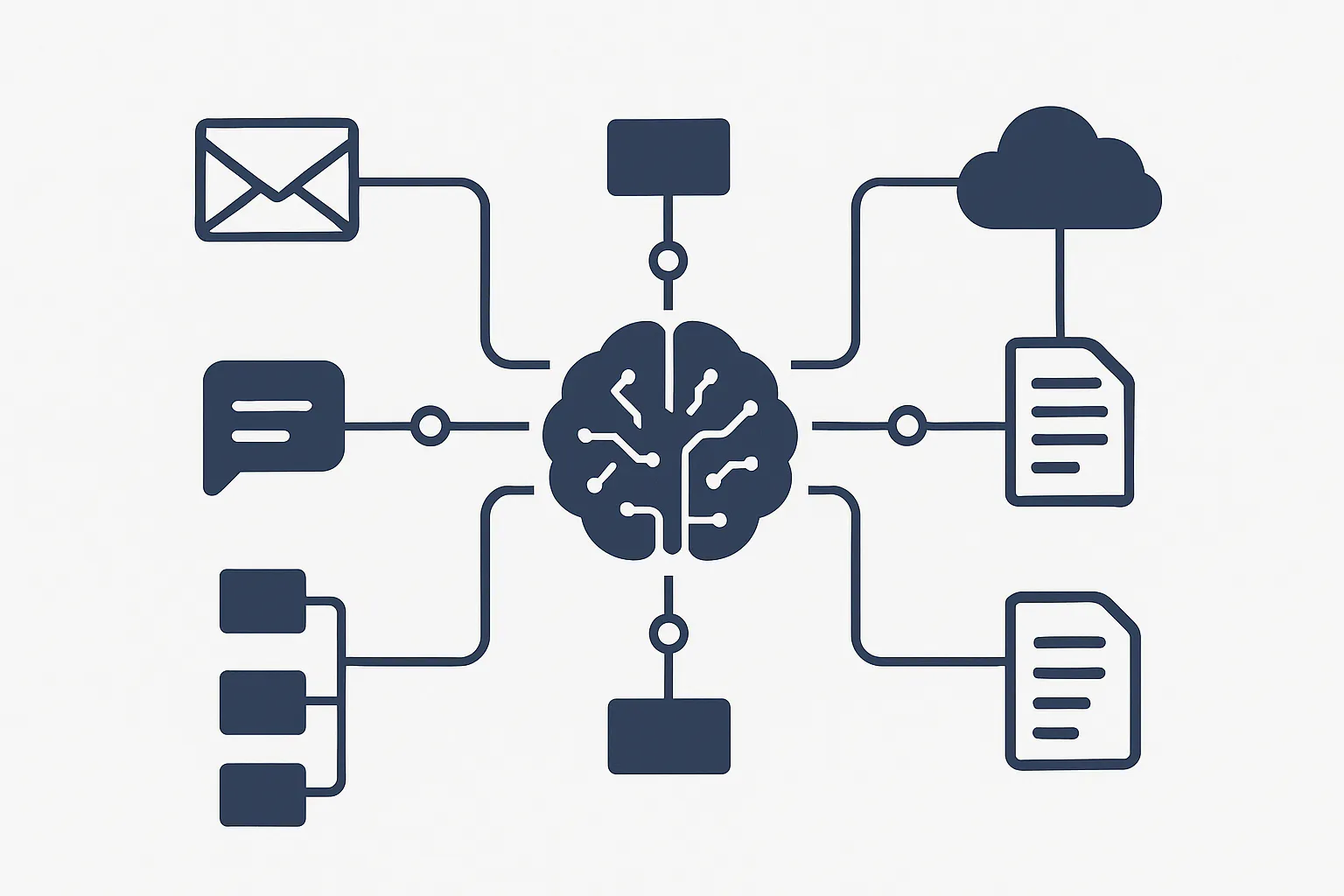Improving Efficiency: Overcome 5 Data Management Challenges
Key Takeaways

Understanding Enterprise Data Management
Managing enterprise data involves much more than simply storing and accessing information. It requires a comprehensive approach that includes the generation, integration, dissemination, and control of data within a business structure. It's the lifeblood that helps maintain effective operational procedures and drives the enforcement of data privacy and security measures. Not only does it ensure adherence to data compliance regulations, but it also cultivates an environment of seamless collaboration and clear communication. A properly designed and implemented enterprise data strategy can lead to efficient internal operations, improved customer relationships, and ultimately, the success of a business. Therefore, understanding the intricacies of enterprise data management is critical for IT managers looking to leverage the power of data to drive their businesses forward. Whether it's through ensuring data quality or employing data integration tools, each step of the data management process plays a vital role in maintaining the overall health of a business's data ecosystem. And with the increasing dependence on data in today's business environment, having a strong grasp of effective data management has become more important than ever.
Identifying Key Challenges
Navigating the complexities of data management necessitates an awareness of potential pitfalls. Some of the common challenges that can disrupt the flow of effective data management include the presence of data silos, the need for rigorous governance and compliance measures, the constant pursuit of data quality, the requirement for standardizing data processes, and the demand for agile and efficient data architecture. It's essential to comprehend these barriers to create a robust and flexible data management strategy. Data silos, for example, lead to isolated data pockets within an organization that hinder efficient data sharing and decision-making. Governance and compliance regulations require meticulous adherence to avoid heavy penalties and reputation damage. Maintaining data quality is imperative for accurate insights, while data processing standardization ensures consistency across various systems. Finally, an adaptable data architecture is key to meeting the ever-evolving big data challenges. Understanding these challenges and developing ways to overcome them can set the foundation for a successful data management plan.
Data Silos and Fragmentation
The fragmentation of data into silos is a common hurdle that impedes the efficient flow of information within an organization. When departments hoard their data, it creates a scenario where insights are not communicated effectively, resulting in subpar decision-making. Therefore, the breakdown of these data silos is crucial to unlocking the full potential of your enterprise's data.
The key to overcoming this challenge lies in integrating these isolated data pockets. This can be achieved through the deployment of data integration tools that collect, merge, and centralize data from disparate sources. Simultaneously, it's important to foster a culture of transparency and collaboration across different departments. This means encouraging teams to share data freely and collaborate on data-driven projects.
Data silo integration not only streamlines your organization's data landscape but also promotes a more holistic view of your operations. This holistic view enables better-informed decisions, enhances collaboration, and ultimately contributes to improved business performance. However, remember, this process should be aligned with your overall enterprise data strategy for consistent and effective results.
Governance and Compliance
An effective data management strategy hinges on the implementation of a comprehensive data governance framework. This framework outlines the specific roles, responsibilities, and procedures for handling enterprise data, providing a structure that ensures information is managed in a consistent and reliable manner. It sets the guidelines for who can access, use, and modify data, under which circumstances, thereby minimizing the risk of data misuse or breach.
Compliance with data regulations also plays a pivotal role in enterprise data management. This involves abiding by a multitude of rules and laws, which can vary based on the industry and the region of operation. Non-compliance can lead to severe penalties, both financially and in terms of reputation. Therefore, establishing a compliance management system is key. This can include regular data audits to identify and rectify any non-compliant activities, conducting periodic training sessions for employees on data compliance regulations, and enlisting the help of compliance experts.
However, governance and compliance should not be perceived as obstacles, but rather integral parts of the overall enterprise data strategy. They form the basis of ethical data handling and establish trust among stakeholders, thus enhancing the overall credibility of the organization.
Ensuring Data Quality
High-quality data forms the bedrock of strategic decision-making within an organization. It's paramount that the data feeding into your enterprise's analytical engines is precise, consistent, and reliable. The presence of erroneous or incomplete data can skew analytical outcomes, leading to misinformed business strategies. Therefore, instituting measures to uphold data quality is a vital element of data management.
To guarantee the reliability of data, routine data audits should be carried out to pinpoint and correct inaccuracies. These audits can assess the data's completeness, relevance, and timeliness, ensuring it aligns with the needs of your enterprise. Additionally, deploying data cleansing tools can help eliminate duplicate entries, correct spelling errors, and fill in missing fields. This process ensures data is as clean and accurate as possible before it's used for analysis or decision-making.
Furthermore, creating and implementing a data quality policy can help maintain the integrity of data over time. This policy should outline the acceptable standards for data entry and editing, defining clear parameters for what constitutes 'quality' data within your organization. It can also lay out procedures for data validation, requiring the review and approval of data before it is used in decision-making processes. By championing these measures, IT managers can foster a culture of data accuracy and consistency within their organizations.
Standardization of Data Processes
An essential cornerstone of efficient data management is the standardization of data processes. Standardization is the practice of establishing a uniform set of procedures for data collection, transformation, and storage. This creates a streamlined data workflow, fostering clarity and consistency across different data systems within your organization.
For instance, a standardized data entry protocol can minimize the occurrence of data inconsistencies, reducing the risk of faulty analytics and misinformed decisions. Additionally, standardization is instrumental in facilitating data integration and interoperability. It ensures that data from diverse sources can be cohesively merged, forming a unified and comprehensive data view.
To implement standardization effectively, businesses need to develop a data processing standardization protocol. This protocol should cover all aspects of data handling, from the point of data generation to its final storage. It must also include guidelines on data validation, cleaning, and formatting.
Employing data integration tools can further assist in maintaining standardized data processes, by automating data transformation and consolidation. These tools can automatically map disparate data sources into a standardized format, increasing efficiency and minimizing the risk of human error.
Remember, standardization is not a one-time effort but a continuous process that requires regular review and adjustment. By embracing data process standardization, organizations can enhance the integrity of their data and make it a reliable asset for decision-making and strategic planning.
Adapting to Agile Data Architecture
With the rapid evolution of business environments and escalating big data challenges, maintaining a traditional, rigid data architecture can hinder a company's progress. It's crucial to adopt a more fluid and scalable data infrastructure that can swiftly adjust to ever-changing data demands and trends. In such a dynamic structure, continuous monitoring and regular enhancements of data systems are key elements to ensure they stay relevant and effective.
Incorporating cloud-based platforms can significantly boost the flexibility and scalability of your data architecture. These platforms allow for easy expansion and modification as your data needs grow or shift. They also provide a collaborative environment that facilitates easy data sharing and integration, thereby addressing the challenge of data silos.
Another effective strategy is to enlist data architects to aid in designing and implementing this agile architecture. They bring a wealth of expertise in handling diverse data sources, ensuring efficient data integration, and anticipating future data trends. Their involvement can help create a flexible, future-proof data architecture that is robust enough to tackle emerging big data challenges.
Adopting an agile data architecture isn't merely a technological shift—it's a strategic move that prepares your organization to quickly adapt and thrive in the increasingly data-dependent business world.
Emerging Challenges and Solutions
As data grows both in volume and complexity, fresh obstacles surface. These span from sophisticated data security threats to the integration of AI and machine learning, and the handling of real-time data. To stay ahead of these curveballs, it's imperative to maintain a pulse on the latest technological advancements, making timely investments in cutting-edge security systems, and ensuring your data strategies are regularly updated to adapt to new demands. Employing data silo integration can also be instrumental in addressing the challenge of real-time data management. Likewise, weaving AI and machine learning into your enterprise data strategy can provide powerful tools for data analysis and prediction, giving your business a competitive edge. Moreover, building a stronger data privacy and security framework can significantly fortify your data infrastructure against emerging threats. Thus, addressing these emerging challenges involves both being proactive in updating your data management practices and reactive in quickly adapting to new technological developments. The goal is not just to survive but to thrive in the evolving data landscape.
Building a Future-Ready Data Management Strategy
Crafting a forward-thinking data management strategy necessitates proactivity and adaptability. The fluid nature of data management requires constant evaluation and evolution of your strategic plan, enabling you to stay ahead of industry developments and adapt to the unique needs of your business. A continuous learning environment, through ongoing staff training on the latest data management best practices, promotes data literacy and competency. Your team's ability to handle data effectively and accurately significantly contributes to the success of your strategy.
Investments in cutting-edge data management tools also play a critical role in keeping your business ahead of the curve. Tools that offer advanced features like real-time data processing, AI-driven analysis, and robust security measures can significantly elevate your data management capabilities.
Collaboration with industry-savvy consultants can bring valuable insights and tailored solutions to the table, further enhancing your strategy. Their understanding of your industry's unique data landscape can help craft a strategy that fits your specific needs, giving you a competitive advantage. This forward-thinking approach to data management prepares your business to not only adapt but excel in the face of future data challenges.
Conclusion
Successfully navigating the complex landscape of data management is crucial for any organization aspiring to succeed in our increasingly digital world. This journey encompasses the dismantling of data silos, upholding the quality of data, compliance with governance regulations, implementing standardized data procedures, and embracing an agile data architecture. Crafting a powerful data management strategy doesn't just streamline operations and boost efficiency. It also empowers informed decision-making and propels business growth. The challenge is intricate, but with a well-planned strategy, the right tools, and an adaptable mindset, IT managers can effectively harness the power of data, turning these challenges into opportunities for their organizations. The key is to stay agile, continuously learn, and always strive for improvement. In doing so, businesses are not only prepared for the future but are also positioned to thrive in it.




